Abstract
Context:
PET/CT scan service is one of the capital intensive and revenue-generating centres of a tertiary care hospital. The cost associated with the provisioning of PET services is dependent upon the unit costs of the resources consumed.
Aims:
The study aims to determine the cost of providing PET/CT Scan services in a hospital.
Methods and Material:
This descriptive and observational study was conducted in the Department of Nuclear Medicine at a tertiary apex teaching hospital in New Delhi, India in the year 2014-15. Traditional costing methodology was used for calculating the unit cost of PET/CT scan service. The cost was calculated under two heads that is capital and operating cost. Annualized cost of capital assets was calculated using methodology prescribed by WHO and operating costs was taken on an actual basis.
Results:
Average number of PET/CT scan performed in a day is 30. The annual cost of providing PET/CT scan services was calculated to be 65,311,719 Indian Rupees (INR) (US$ 1,020,496), while the unit cost of PET scan was calculated to be 9625.92 INR (US$ 150). 3/4th cost was spent on machinery and equipment (75.3%) followed by healthcare personnel (11.37%), electricity (5%), consumables and supplies (4%) engineering maintenance (3.24%), building, furniture and HVAC capital cost (0.76%), and manifold cost (0.05%). Of the total cost, 76% was capital cost while the remaining was operating cost.
Conclusions:
Total cost for establishing PET/CT scan facility with cyclotron and chemistry module and PET/CT scan without cyclotron and chemistry module was calculated to be INR 610,873,517 (US$9944899) and 226,745,158 (US$3542893), respectively. (US$ 1=INR 64)
Key Messages: The cost of establishing and operating PET/CT scan facility is quite substantial. Therefore, focus should be on optimal utilisation of resources and this requires constant monitoring of resource flow in the facility. This cost analysis can also be used for planning a similar facility in a similar setting.
Keywords: Cost analysis, PET/CT scan, traditional costing, unit cost
Introduction
Nuclear medicine is a branch of medical imaging that uses small amounts of radioactive material to diagnose and determine the severity of or treat a variety of diseases, including many types of cancers, heart disease, gastrointestinal, endocrine, neurological disorders and other disorders. Given the ability of nuclear medicine procedures to pinpoint molecular activity within the body, it has a potential role in an early diagnosis as well as patient's immediate response to therapeutic interventions.[1] PET and CT are established imaging modalities that have been validated and extensively utilized in routine clinical practice. Integrated PET/CT combines PET and CT in a single imaging device and allows morphological and functional imaging to be carried out in a single sitting. At the same time, there is greater awareness that the quantitative features of PET may have a major impact in oncology trials and clinical practice.[2]
In some developing countries (with middle-income economies), where there has not been a reference unit cost and/or standard hospital costing system for medical services, individual hospitals conduct cost analysis employing different methods. The adoption of different methodologies results in non uniform cost outcomes, which cannot be compared or utilized by other organizations. The information on unit costs of medical services is needed for performance based budgeting systems and financing methods of different types of insurance schemes.[3] The public sector, especially in developing nations, has suffered from poor accounting and management systems for quite long time. In hospitals, there is a need for better cost management systems arising from efficiency problems and lack of resources.[4]
The cost associated with the provisioning of PET services depends on the unit costs of the resources consumed. PET/CT scan services are one of the major capital intensive and revenue-generating centres of a hospital. Imaging technology represents a sizeable investment of resources in the hospital leading to an increase in the patient care costs. With the advancement of new technology and with more sophisticated tests and procedures, it is important to understand the utilization of resources, to bring cost consciousness and rational use of resources. Hence, it becomes imperative to study various cost centres and costs involved in the delivery of PET/CT scan services. There are limited, if any, studies with regard to costing of PET/CT scan facility in India.
AIIMS, being an apex healthcare institute in the country, it is essential that the costing of radio-imaging service is done as calculating the unit cost of services. This study aims to determine the cost of providing PET/CT Scan services in a hospital. This study will help in understanding the resource consumption pattern, which can guide for future allocations/ redistribution of allocations as well as for reviewing the policy guidelines on budgeting of the centres. Further cost analysis of establishing new PET/CT scan services will facilitate better value of the services as well as bench mark for replicating developmental activities in the future elsewhere.
Subjects and Methods
This study was carried out in the Department of Nuclear Medicine at a tertiary apex referral hospital in New Delhi, India from June 2014 to July 2015. It was observational and descriptive in nature. The traditional (syn-average or gross) costing methodology was used to arrive at the unit cost of PET scan from the providers perspective for the year 2014-15. The cost was calculated under two heads as capital and operating cost. Following cost centres were included in the study [Table 1]. Equipment not related to cyclotron (SPECT/CT, gamma camera and gallium module), land cost (donated by Government of India), insignificant cost attributable towards provisioning of supportive services that is CSSD, laundry, and medical records departments were not included in the study.
Table 1.
Cost centres included in the study

Capital Assets-Annualized Cost[5]
To arrive at the annualized cost of the capital assets, replacement cost was calculated by multiplying procurement cost with cost inflation multiplication factor (cost inflation index for 2014-2015/cost inflation index of procurement year). Thereafter, the annualized method of depreciation was applied to arrive at the annual cost by dividing replacement cost of the asset in the year 2014-15 by the annualization factor.
The formula for calculating the annualization factor is (1/r) × [1-1/(1+r)n] where:
– r is the real interest rate, which is calculated by the following formula:
[(1+nominal interest rate)/ (1+annual inflation)-1]
Nominal interest rate is the prevailing national bank savings rate for the year 2014.
– n is the number of years of life [100 years,10 years (15 years) for building, and machinery and equipment (fixed), respectively.
Following the above-mentioned methodology, equipment cost was calculated. Similarly, annualized equipment cost was calculated for PET/CT scan services and same was obtained for furniture and fixtures. The cost of equipment was retrieved from the stores department. Equipments which were only dedicated for PET/CT scan facility was taken into account. For building, furniture and fixed machineries, straight line method of depreciation was applied.
Building cost was calculated using Central Public Works Department (A central agency prescribing the construction rates) manual plinth area rate.
Operating cost
Unstructured interviews were held with the hospital staff of Nuclear Medicine Department for PET/CT scan facility, and departmental records were also studied to gain an insight into the functioning of PET/CT scan services. It was done to calculate the time devoted by various categories of staff to apportion their salaries. The actual salary of employees was taken from the accounts section.
To calculate floor area of Nuclear Medicine Department, records from the engineering department were studied. Building maintenance cost was taken from the Central Public Works Department building maintenance manual. The cost of operating and maintenance of HVAC was taken from engineering division.
The cost of consumables was taken for a period of 1 year to account for the fluctuation in consumption. It was assumed that consumables indented by the staff in the year of study were consumed in the same year. Actual quantity as per indent book was considered and the cost of the same was taken from different rate contracts of the hospital. Electricity cost was derived by recording total number of equipment and machineries dedicated for PET/CT scan facility, and per day consumption was calculated which was later on multiplied by per unit cost to derive the annual cost of electricity consumption. The proportion of OT terminal manifold units to the total terminal units of medical gases, compressed air and vacuum was used as an apportioning criterion for various costs (capital and operating cost).
The cost was also calculated to set up a new PET facility with The cost was also calculated to set up a new PET facility with (Model 1) and without (Model 2) cyclotron. For this, cost references were taken from AIIMS cost centres including capital cost and operating cost for 5 years. Similar method of depreciations were taken into account and for model 2, total area and total furniture /fixtures were assumed to be 50% of model 1 facility and the cost for cyclotron and chemistry models were excluded in this facility.
Results
This leading apex tertiary referral hospital in New Delhi was established as an institution of national importance by an Act of Parliament. It's objectives were to develop patterns of teaching in Undergraduate and Post-graduate Medical Education in all its branches so as to demonstrate a high standard of Medical Education in India; to bring together in one place educational facilities of the highest order for the training of personnel in all important branches of health activity; and to attain self-sufficiency in Post-graduate Medical Education.
PET/CT scan facility is located at ground floor of hospital and was started in year the 2005. It is spread over an area of 200 square meters and has one cyclotron, one chemistry module with 2 PET/CT scanner to provide diagnostic facility. The centre also acts as a referral hospital for Delhi National Capital Region and neighbouring states, where patients are sent by regional public hospitals for the diagnosis of various diseases including Oncology, Cardiology, Gastroenterology, and Neurological disease. A total of 6785 PET/CT scans were performed in the nuclear medicine department in the year 2014-15 [Table 3]. On an average, daily 30 PET/CT scans were performed in a year, and cost estimates were calculated for the financial year 2014-15. The annualization factor for capital assets was calculated to be 8.3 and 19.60 for equipments and cyclotron, respectively. For building, fixed machineries, furniture/fixtures, straight line depreciation method was used assuming useful life year 100, 15 and 5 respectively.
Table 3.
PET/CT scan census for year 2014/15 at AIIMS, New Delhi
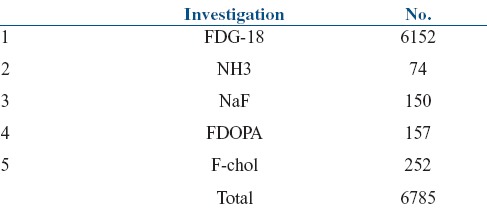
PET/CT scan facility Cost
Depreciated PET/CT scan facility building cost and engineering maintenance cost for 2014-15 was calculated to be INR 96,904 ($1,514) and INR 1,020,800 ($15,950), respectively [Table 2]. Total annualized cost of PET/CT scan facility equipment was calculated to be INR 49,194,701 ($768,667) [Table 2]. Equipment maintenance cost was not included, as cost of comprehensive annual maintenance /annual maintenance was loaded in the cost of the equipment. Depreciated Cost for furniture/fixtures for the year 2014-15 was calculated to be INR 272,052 ($ 4,250) [Table 2]. Depreciated HVAC cost and its annual operating and maintenance cost was calculated to be INR 140,000 ($2,187) and INR 1,100,000 ($17,187), respectively [Table 2]. Human resource cost of the PET/CT scan facility was calculated to be INR 7,430,667 ($116,104) per year. The yearly cost of chemicals and supplies for radioisotopes for the year 2014-2015 was found to be INR 2,346,689 ($36,667) and for consumables was found to be INR 334,978 ($5,234) [Table 2]. Electricity cost for the year 2014-15 was calculated to be INR 3,337,400 ($52,147) [Table 2].
Table 2.
Cost Summary of PET/CT scan facility at Nuclear Medicine Department, AIIMS
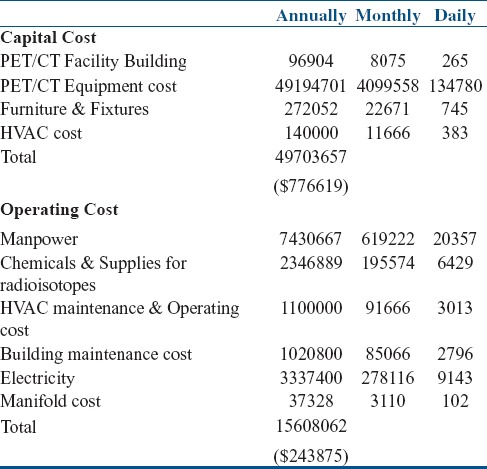
Support Services Cost PET/CT scan facility manifold terminal units are only two and were derived from the per terminal cost, which were derived from the previous study at AIIMS.[6] The total cost of manifold terminal for 2014-2015 was calculated to be INR 37,328 ($583). Capital and operating cost was calculated to be INR 49,703,657 ($776619) and 15,608,062 ($243875), respectively [Table 2].
[Table 2] gives the detailed information on the capital and operating cost of the PET/CT scan services. Annual cost of providing PET/CT scan services at AIIMS, New Delhi was calculated to be INR 65,311,719 ($1020495). Of the total operating room cost, 76% is capital cost while 24% is operating cost [Figure 1]. The PET/CT scan facility expenditure mainly comprised of three major components contributing to more than 95% of the cost that is equipment cost, manpower cost and the cost of electricity [Figure 2].
Figure 1.
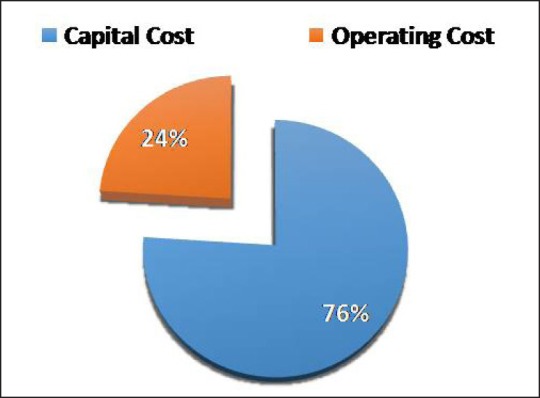
Proportion of Operating and Capital cost of PET/CT scan at AIIMS
Figure 2.
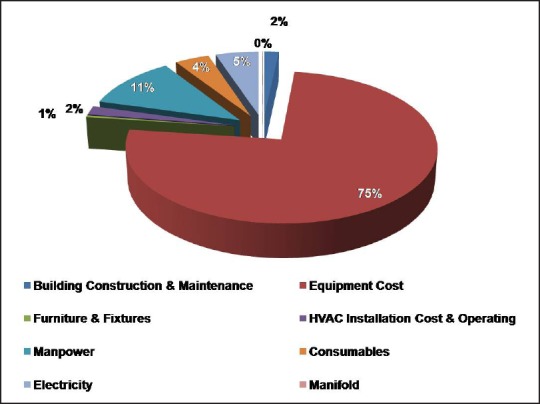
Cost Breakdown of PET/CT scan facility
Unit cost was derived using formula:

Total number of PET/CT scan done in study period (July 2014- June 2015) was 6875. Therefore, Unit cost of PET/CT was calculated to be INR 9,625.22 ($150)
For establishment of PET/CT facility with cyclotron (Model 1) and PET/CT scan facility without cyclotron (Model 2) total cost was calculated to be INR 610,873,517 ($9,544,899) and INR 226,745,158 ($3,542,893) respectively, where all the cost were derived with reference to PET/CT facility of AIIMS and operating cost was taken for 5 years. In the public sector, for establishing any new facility in India, it requires projection of operating cost of next 5 years along with the capital cost of establishing it to secure funds from the government under the plan budget. [Table 4] and [Table 5] provides total capital and operating cost required for establishing model 1 and model 2 facility, respectively [Figure 3] and [Figure 4].
Table 4.
Total cost required for establishment of Model 1 PET/CT facility
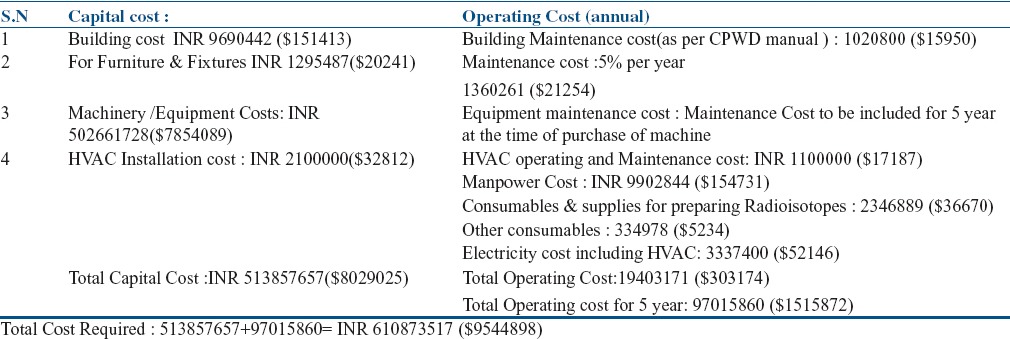
Table 5.
Total cost required for establishment of Model 2 PET/CT facility
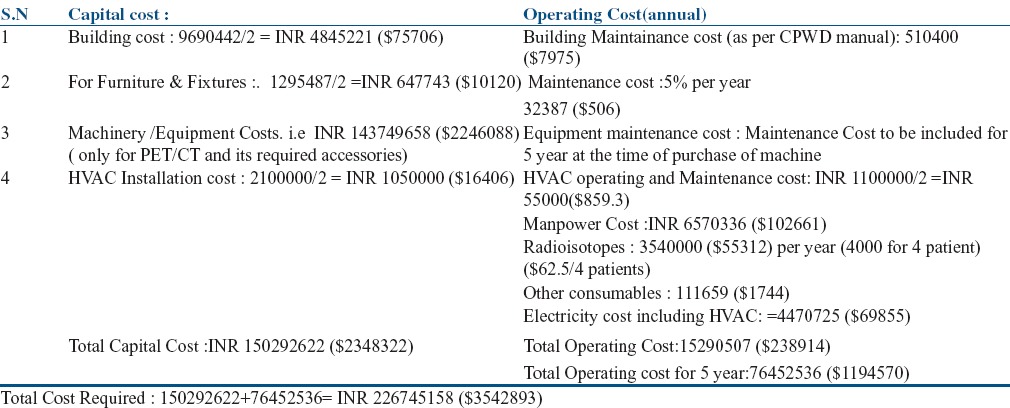
Figure 3.
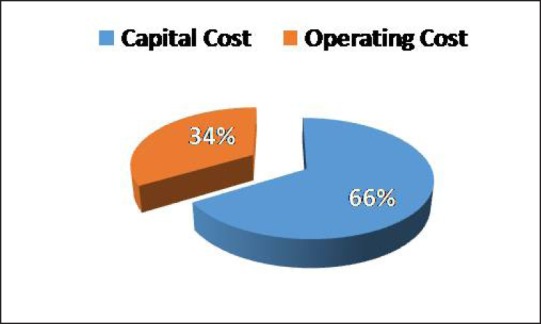
Total Capital and Operating Cost Required for Model 1 PET/CT facility
Figure 4.
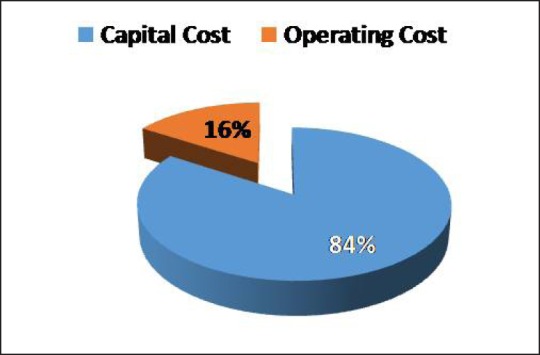
Total Capital and Operating Cost Required for Model 2 PET/CT facility
Discussion
Limited studies are done for the cost analysis of PET/CT scan. Some studies done in the different parts of the world even indicates that the cost of performing PET/CT scan is comparatively less with references to our study. Previous study done in Iran[7] found that the total cost required to set up a Model 1 PET scan facility with average 3000 scan per year is 8.2 million US$ and 3.7 million US$ for Model 2 PET/CT scan facility resulting in US$300-US$450 per PET scan performed; where as in our study the cost per PET/CT performed is only $150.
The costs for PET and PET/CT are decreasing as number of examination performed are increasing. In Germany, costs per examination range between approximately $885-$1,474, the amount for production and delivery of radiopharmaceuticals is approximately $265-$383 per scan.[8] Similar survey in done in Great Britain, costs per PET scan were derived to be $1,030-$2,109. In the United States, reimbursement for PET and PET/CT is provided by the Medicare program, which reimburses a median amount of $952.83. The amount consists of $855.43 for the examination and $97.40 for the analysis.[9] These comparison of surveys from different parts of the world even shows that the cost of PET/CT scan in India is relatively low.
In India, there has been a tremendous increase in the number of imaging systems since 2004. Majority of the PET/CT scanners and cyclotrons are in the private setup and scanners situated in different locations share the isotope produced from one cyclotron. The cost of PET/CT scan in government institutions varies between Rs. 2000 and Rs. 10000, the average being Rs. 6000 whereas in private sectors, the cost for a whole body PET/CT scan is Rs. 15000-27000, depending on the type of protocol. The studies in government institutes are higher in number than those done in private centres. In a government institutional setup about 15-25 whole-body studies are done in a day. In the private sector the number is 5-15, with eight per day being a good average.[10]
Various strategies for cost cutting can be applied both in terms of capital cost and operating cost of PET/CT scan, which can even decrease the unit cost of PET/CT scan. In capital cost, Cyclotron can be used in cooperative basis with many of the other institute or radioisotopes can be procured in cooperative basis. Similarly instead of building a separate facility, it can be incorporated in the same institute following the regulatory and legal formalities. Equipments, furniture and supplies can be procured in a bulk to reduce the cost. The strategies for reducing operating cost may involve reducing excessive service levels, utilizing the staffs in optimal level, changing processes through adopting automation, altering timing, periodic equipment and energy audit, and eliminating exceptions. A well planned contract formulation including service contract, composite cost, warranty on spares and turnkey installation are also the strategies for cost cutting.
The study was carried out at a government institute; hence, data availability was one of the major weaknesses of this study. The study considered the major cost centres towards the provisioning of PET/CT scan services.
The results of this study also suffer from the disadvantages associated with traditional or average costing methodology. However, in a developing country like India, it is difficult to carry out activity-based costing due to lack of awareness and record keeping issues and accounting methods.
Conclusion
This study at a tertiary apex referral centre of India was conducted to gain an insight regarding the amount of resources being dedicated towards the provisioning of PET/CT scan services at one of the apex tertiary care centre in the country. The results of this costing will act as rough estimates for planning for PET/CT scan facility in a similar setting in India and neighbouring countries. A large amount of resources were devoted towards equipment (75%) followed by manpower cost (11%), cost of electricity (5%), consumables and supplies (4%), engineering maintenance cost (3.24%), building, furniture and HVAC capital cost (0.76%), and manifold cost (0.05%). The average number of scan performed in the AIIMS Hospital per day with 2 PET/CT scanners is 30.
The hospital, being a matrix organisation, may require huge resources and time to arrive at the apportioning of the resources not only in terms of equipment and human resources but in other resources as well. Land cost was excluded from the study since the land where the nuclear medicine service is located was donated by the Government. The cost contributed by the excluded departments would have a minimal insignificant impact on the final outcome of this study. However, this costing of PET/CT facility may be an under-estimation of the real cost.
Financial support and sponsorship
Nil.
Conflicts of interest
There are no conflicts of interest.
References
- 1.Positron Emission Tomography - Computed Tomography (PET/CT) [Internet]Radiological Soceity of North America. 2013. [Last accessed on 2015 Jun 10]. p. 1. Available from: http://www.radiologyinfo.org/en/infocfmpg=pet .
- 2.Bouchelouche K, Turkbey B, Choyke P, Capala J. Imaging prostate cancer: An update on positron emission tomography and magnetic resonance imaging. Curr Urol Rep. 2010;11:180–90. doi: 10.1007/s11934-010-0105-9. [DOI] [PMC free article] [PubMed] [Google Scholar]
- 3.Riewpaiboon A, Malaroje S, Kongsawatt S. Effect of costing methods on unit cost of hospital medical services. Trop Med Int Health. 2007;12:554–63. doi: 10.1111/j.1365-3156.2007.01815.x. [DOI] [PubMed] [Google Scholar]
- 4.Siddharth V, Kumar S, Vij A, Gupta SK. Cost Analysis of Operation Theatre Services at an Apex Tertiary Care Trauma Centre of India. Indian J Surg. 2015;77(Suppl 2):530–5. doi: 10.1007/s12262-013-0908-2. [DOI] [PMC free article] [PubMed] [Google Scholar]
- 5.Shepard DS, Hogdkin D, Anthony YE. Analysis of hospital costs: a manual for managers [Internet] World Health Organisation. 2000. [Last accessed on on 2015 Jul 25]. Available from: http://whqlibdoc.who.int/publications/2000/9241545283.pdf .
- 6.Kumar P, Gupta SK, Sharma D, Batra RK. Operating Manifold Services in Hospitals: A costly affair? J Nurs Heal Care. 2014;1:143–7. [Google Scholar]
- 7.Akbari Sari A, Ravaghi H, Mobinizadeh M, Sarvari S. The Cost-Utility Analysis of PET-Scan in Diagnosis and Treatment of Non-Small Cell Lung Carcinoma in Iran. Iran J Radiol. 2013;10:61–7. doi: 10.5812/iranjradiol.8559. [DOI] [PMC free article] [PubMed] [Google Scholar]
- 8.Facey k, Bardbury L, Laking G, Payne E. Overview of the clinical effectiveness of positron emission tomography imaging in selected cancers. Health Technol Assess. 2007;11:267. doi: 10.3310/hta11440. [DOI] [PubMed] [Google Scholar]
- 9.Buck AK, Herrmann K, Stargardt T, Dechow T, Krause BJ, Schreyogg J. Economic Evaluation of PET and PET/CT in Oncology: Evidence and Methodologic Approaches. J Nucl Med Technol. 2010;38:6–17. doi: 10.2967/jnmt.108.059584. [DOI] [PubMed] [Google Scholar]
- 10.Rangarajan V, Purandare NC, Sharma AR, Shah S. PET/CT: Current status in India. Indian J Radiol Imaging. 2008;18:290–4. doi: 10.4103/0971-3026.43840. [DOI] [PMC free article] [PubMed] [Google Scholar]


